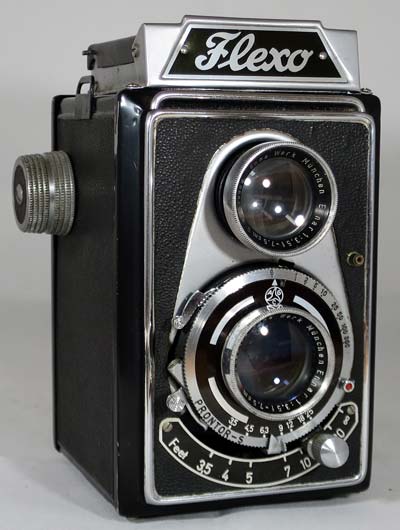Lipca Flexo
Specification

| Manufacturer | : | Lipca |
|---|---|---|
| Produced | : | 1951 |
| Classification | : | Medium Format |
| Body Type | : | Twin Lens Reflex |
| Construction | : | Metal |
| Film Type | : | 120 |
| Film Width | : | 62mm |
| Image Size | : | 6 x 6 cm |
| No. of Images | : | 12 |
| Lens Type | : | Ennar |
| Focal Length | : | 75mm |
| Focus Type | : | Variable |
| Focal Range | : | 3.5ft - inf. |
| Aperture Type | : | Iris |
| Apertures | : | f/3.5 - f/25 |
| Shutter Type | : | Prontor S |
| Shutter Speeds | : | T, B, I(1/300s to 1 sec) |
| Size Viewfinder Open (w x h x d) | : | 88 x 180 x 100 mm |
| Size Viewfinder Closed (w x h x d) | : | 88 x 135 x 100 mm |
| Weight | : | 720g |
Art Deco Credentials
![]()
Limited: Minor and insubstantial
I consider this camera to warrant 1 star for the following attributes:
- produced after the main Art Deco period
- geometric aluminium plate around the two lenses
- chrome embellishment around face plate
- Art Deco font
Description
The Flexo is a German TLR made by Lipca. Lipca was the trademark of Lippische Camerafabrik Production started in 1948 with the first version and ended in 1951 with the fourth version.
The first Flexo : lens engravings on the side of the front lens mount.
The second Flexo : lens engravings on the front lens name ring.
The third Flexo : wire sports finder
The fourth Flexo : reinforced bottom plate.
Camera shown above is forth version.
The Flexo takes 12 6×6cm pictures on 120 film. Film transport uses a knob and film advance is checked through a red window on the back. It has two different finders: a waist level finder with folding loupe and a wire frame finder with an eyelet. This sports frame finder slides into the front plate.
The shutter is a Prontor-S with speeds of B, 1-1/300s. The shutter is armed with one lever and fired with another around the taking lens. It has a cable release socket. A shutter delay timer is provided.
The iris of the aperture is controlled by a lever under the taking lens. The aperture values seem odd providing f/3.5, f/4.5, f/6.3, f/9, f/12, f/18 and f/25.
It has a helical focusing system operated by lever below lens. Identical taking and viewing lenses ensure that focussing can be checked in the viewfinder with the image projected onto a ground glass screen. There is a loupe for getting a close-up of the screen. When focusing, the front plate stays in place and only the lens tubes move. Two variations are found, one with a scale in feet and one with a meter scale. A handy depth of focus guide is found on the rear plate of the viewfinder.
Loading the film is done by opening the back door, pulling out the winding knob and withdrawing the transport system - similar to the way box cameras work.
A tripod socket is provided on the base and a PC flash socket is found on the lens plate.
How to Use
If you don't want to bother with an exposure meter, follow the guide shown. It is based on the 'Sunny 16' rule. Film is so forgiving and will produce acceptable results even when overexposed by 2 or 3 stops or underexposed by 1 stop.
Remember that the exposure guide that is found on the camera may not be helpful as it is based on the use of old film with a low ISO value.
The tables assume that the sun is at least 30 degrees above the horizon - that's 10am - 5pm on a summer's day in the UK.
If you are not sure about the light level, err on the side of overexposure - i.e. assume the smaller f number.
Where there is a choice, a larger f number will give a larger depth of field.
For the slower speeds, you may need a tripod to stop blur through shake.
Note that because of the odd aperture values, I have erred on the side of over-exposure which negative film handles well.
Using ISO 100/125 film
| Weather Conditions | Shadow Detail | Shutter Speed (s) | ||
|---|---|---|---|---|
| 1/25 | 1/50 | 1/100 | ||
 Sunny SunnySnow/Sand | Dark with sharp edges | - | f/25 | f/18 |
 Sunny Sunny | Distinct | f/25 | f/18 | f/12 |
 Slight Overcast Slight Overcast | Soft around edges | f/18 | f/12 | f/9 |
 Overcast Overcast | Barely visible | f/12 | f/9 | f/6.3 |
 Heavy Overcast Heavy Overcast | None | f/9 | f/6.3 | f/4.5 |
 Open Shade Open Shade/Sunset | None | f/6.3 | f/4.5 | f/3.5 |